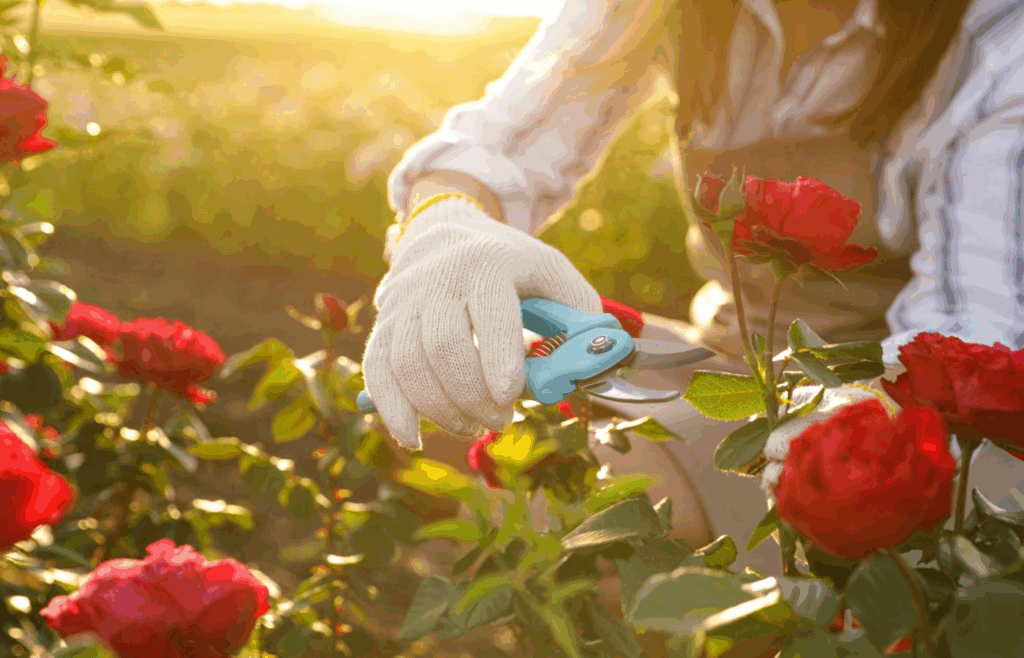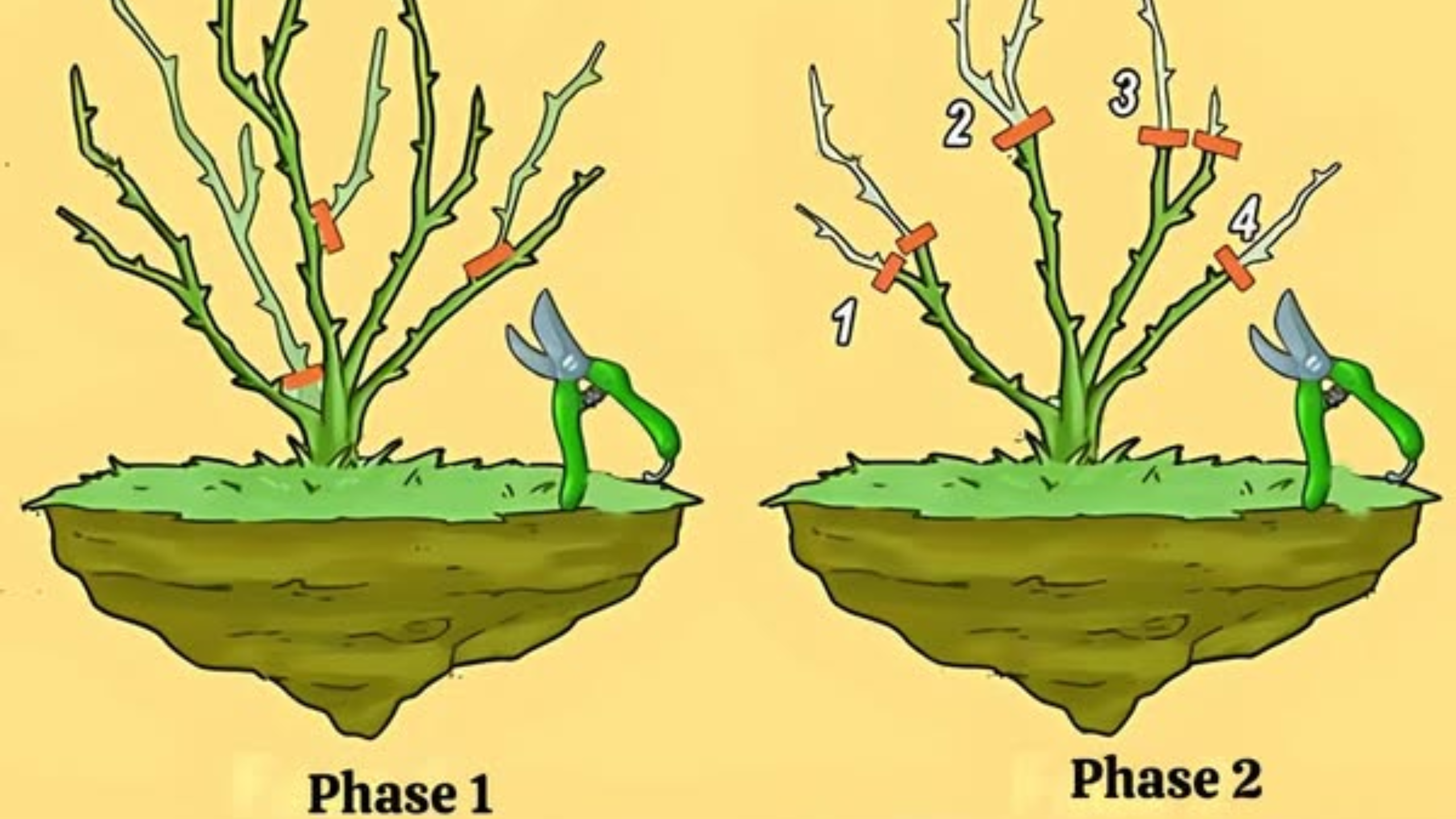Roses, with their stunning blooms and captivating fragrance, are beloved plants in our gardens. To keep them thriving and encourage abundant flowering, proper pruning is essential. Pruning roses may seem daunting, but by following a few simple steps, you can achieve excellent results. In this guide, we’ll walk you through each step of the process, ensuring your roses remain beautiful and healthy throughout the year.
1. Choose the Right Time to Prune: When is the Ideal Time?
Timing is crucial when it comes to pruning roses. The optimal time to prune is at the end of winter or early spring, before new growth begins. This usually happens between February and April, depending on your region. Pruning too early can risk frost damage, while pruning too late may disrupt growth. It’s important to choose a time when the risk of frost has passed, but before the rose starts to grow actively. Pruning at the right time ensures the best chance for healthy growth.

2. Prepare the Right Tools: Be Ready for the Job
Before starting, it’s essential to make sure you have the right tools. A good pair of bypass secateurs is a must. These allow for clean, precise cuts. Ensure the blades are sharp to avoid damaging the rose stems. Don’t forget to disinfect your tools before use to prevent the spread of diseases between plants. Depending on the size of your roses, you may also need a pruning saw for thicker branches. Additionally, wear garden gloves to protect your hands from thorns.
3. Evaluate the Rose: Identify Branches to Remove
Once your tools are ready, it’s time to evaluate your rose. Examine it carefully to spot any dead, diseased, or damaged branches. These need to be removed, as they weaken the plant and can contribute to disease. Removing these parts also redirects the rose’s energy toward healthier growth. Also, check for any branches that are crossing or rubbing against each other, as these can cause wounds and create entry points for infections.
4. Make the First Cuts: Remove Dead or Damaged Parts
Start by cutting away any dead or damaged branches. Always cut at an angle, right down to the healthy tissue of the branch. Ensure your cuts are clean, as this will help the plant heal better. A good rule of thumb is to prune just above an outward-facing bud. This encourages the growth to go outward, promoting a well-balanced structure. Make sure to prune toward the outside to prevent water from pooling, which can lead to rot.
5. Thin Out the Rose: Improve Air and Light Circulation
One of the most important steps in pruning roses is ensuring good air and light circulation within the plant. To achieve this, you’ll need to thin out the rose by removing thin, weak, or inward-growing branches. This allows air to flow freely through the plant and lets light reach the inner parts of the rose. Proper thinning encourages vigorous growth and healthy blooms. A well-thinned rose is also less prone to attracting diseases.
6. Shape the Rose: Create a Balanced Form
To encourage healthy, balanced growth, you’ll also need to shape your rose. The goal is to create an open vase-like shape that facilitates air circulation and ensures every branch gets adequate light. When pruning, focus on outward-facing buds. This will help the rose grow outward, forming a strong and well-structured plant. By avoiding excessive cutting, you preserve the natural balance of the plant while promoting better growth.
7. Final Touches: Protect and Prepare for New Growth
Once you’ve completed the pruning, you can apply the finishing touches to protect the plant. If you made significant cuts, it might be helpful to apply a sealant on the larger wounds. This prevents infections and helps the plant heal. Next, clean up around the rose by removing cut branches and dead leaves. This helps maintain a healthy environment for the plant and minimizes the risk of diseases.
Care After Pruning: Helping Your Roses Recover
After pruning, your roses will need care to recover from the procedure. Water them thoroughly to hydrate them and support recovery. Applying a balanced fertilizer in the spring will promote strong new growth as the season begins. Be sure to follow the specific recommendations for your rose variety and soil type. Proper aftercare ensures not only the health of your roses but also an outstanding display of flowers throughout the year.
By following these simple steps, you can ensure a successful and beneficial pruning for your roses. With a little care and attention, you’ll enjoy healthy roses and abundant blooms every year. Remember, each pruning is an opportunity to strengthen the health of your plants and create a flourishing garden.


buy amoxicillin tablets – combamoxi.com amoxil buy online
buy generic fluconazole online – https://gpdifluca.com/# buy generic forcan for sale
order cenforce – cheap cenforce 50mg cenforce 50mg brand
cialis cheapest price – https://ciltadgn.com/ us cialis online pharmacy
buy generic zantac for sale – https://aranitidine.com/# zantac drug
viagra sale europe – https://strongvpls.com/ buy viagra without rx
Proof blog you be undergoing here.. It’s severely to on strong quality belles-lettres like yours these days. I truly comprehend individuals like you! Rent vigilance!! cenforce 25 opiniones
With thanks. Loads of knowledge! https://buyfastonl.com/
I couldn’t weather commenting. Profoundly written! https://ursxdol.com/sildenafil-50-mg-in/
More articles like this would make the blogosphere richer. https://prohnrg.com/product/lisinopril-5-mg/
I’ll certainly carry back to review more. https://aranitidine.com/fr/ivermectine-en-france/
More text pieces like this would create the web better. https://ondactone.com/spironolactone/
I couldn’t resist commenting. Well written!
celecoxib oral
Facts blog you be undergoing here.. It’s obdurate to on strong worth writing like yours these days. I really comprehend individuals like you! Take mindfulness!! http://www.underworldralinwood.ca/forums/member.php?action=profile&uid=488144
buy dapagliflozin 10mg generic – https://janozin.com/ forxiga 10 mg usa
order orlistat generic – click buy xenical 60mg pills
This is the stripe of topic I take advantage of reading. https://experthax.com/forum/member.php?action=profile&uid=124786
You can shelter yourself and your ancestors close being alert when buying medicine online. Some pharmacopoeia websites function legally and offer convenience, privacy, cost savings and safeguards for purchasing medicines. buy in TerbinaPharmacy https://terbinafines.com/product/atarax.html atarax
Thanks on sharing. It’s acme quality. commande cialis super active
I’ll certainly bring to review more.
https://t.me/officials_pokerdom/3712
https://t.me/s/BeEFCaSiNo_oFfIcIALs
Dann spielen Sie jetzt online! Tickets für Veranstaltungen im Stadtcasino Basel können Sie online direkt bei den jeweiligen Veranstaltern erwerben. Wenn du dich
entscheidest, um echtes Geld zu spielen, stelle bitte sicher, dass du nicht mehr
spielst, als du es dir finanziell leisten kannst zu verlieren. Casinospieler erhalten präzise Informationen über
sichere Online-Glücksspiele und Online-Casinos in der Schweiz.
Dank seiner Erfahrung und fundierten Kenntnisse in diesen Bereichen liefert er wertvolle Informationen für Casinospieler in der Schweiz.
Das Casino in Basel zählt zu den insgesamt 11 Casinos, bei denen die Spieler bereits ab einem Schweizer Franken um den riesigen Schweizer Jackpot spielen können.
Dazu gehören zum Beispiel Hochzeiten oder Seminare. Zudem bietet die Spielbank Basel regelmäßig
Frauen- und Männerabende an. Das liegt zum einen an der großen Spielauswahl,
zum anderen am umwerfenden Ambiente.
References:
https://online-spielhallen.de/admiral-casino-auszahlung-ihr-weg-zum-gewinn/